47 start with M start with M
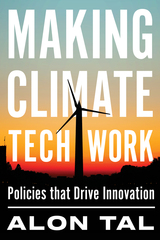
In Making Climate Tech Work, environmental policy expert Alon Tal demystifies climate innovation programs around the world—no policy background needed. Beginning with a review of government’s general role in technology policy development, Tal assesses each policy alternative, describing eye-opening experiments in diverse countries, presenting a range of case studies, interviewing leading decarbonization experts, and interpreting new empirical data. Discover how Germany incentivized renewables; Denmark became a wind energy superpower; Australia phased out incandescent bulbs; California’s prisons pioneered low-carbon menus; and why carbon taxes have failed around the world—but could be designed for success.
Tal distills the benefits and drawbacks of each policy, along with related ethical questions and public perceptions. He concludes by addressing two commonly overlooked issues in climate policy: disruption of workers’ livelihoods from the clean energy transition; and integrating the Global South into the planet’s new low-carbon economy—as the region that has contributed least to climate change but which must be part of a global solution. Tal not only evaluates which policy strategies effectively reduce emissions but also how they can promote climate tech innovation.
Humanity is ultimately in a race against time and effective climate policies are critical to ensure a sustainable future. Making Climate Tech Work serves as an essential primer for policymakers, academics, activists, and anyone interested in climate solutions.
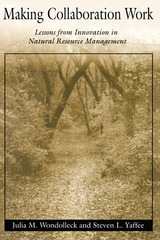
Across the United States, diverse groups are turning away from confrontation and toward collaboration in an attempt to tackle some of our nation's most intractable environmental problems. Government agencies, community groups, businesses, and private individuals have begun working together to solve common problems, resolve conflicts, and develop forward-thinking strategies for moving in a more sustainable direction.
Making Collaboration Work examines those promising efforts. With a decade of research behind them, the authors offer an invaluable set of lessons on the role of collaboration in natural resource management and how to make it work. The book:
- explains why collaboration is an essential component of resource management
- describes barriers that must be understood and overcome
- presents eight themes that characterize successful efforts
- details the specific ways that groups can use those themes to achieve success
- provides advice on how to ensure accountability
Making Collaboration Work will be an invaluable source of ideas and inspiration for policy makers, managers and staff of government agencies and nongovernmental organizations, and community groups searching for more productive modes of interaction.
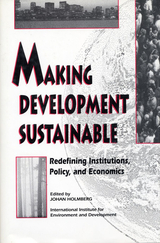
Making Development Sustainable is an integrated series of essays on the policies for sustainable development from one of the leading policy research institutes for environmental and development issues.

This book provides a far-reaching follow-up to the pathbreaking Urban Sprawl and Public Health, published in 2004. That book sparked a range of inquiries into the connections between constructed environments, particularly cities and suburbs, and the health of residents, especially humans. Since then, numerous studies have extended and refined the book's research and reporting. Making Healthy Places offers a fresh and comprehensive look at this vital subject today.
There is no other book with the depth, breadth, vision, and accessibility that this book offers. In addition to being of particular interest to undergraduate and graduate students in public health and urban planning, it will be essential reading for public health officials, planners, architects, landscape architects, environmentalists, and all those who care about the design of their communities.
Like a well-trained doctor, Making Healthy Places presents a diagnosis of--and offers treatment for--problems related to the built environment. Drawing on the latest scientific evidence, with contributions from experts in a range of fields, it imparts a wealth of practical information, with an emphasis on demonstrated and promising solutions to commonly occurring problems.
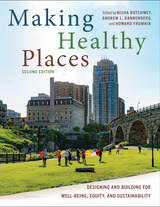
In Making Healthy Places, Second Edition: Designing and Building for Well-Being, Equity, and Sustainability, planning and public health experts Nisha D. Botchwey, Andrew L. Dannenberg, and Howard Frumkin bring together scholars and practitioners from across the globe in fields ranging from public health, planning, and urban design, to sustainability, social work, and public policy. This updated and expanded edition explains how to design and build places that are beneficial to the physical, mental, and emotional health of humans, while also considering the health of the planet.
This edition expands the treatment of some topics that received less attention a decade ago, such as the relationship of the built environment to equity and health disparities, climate change, resilience, new technology developments, and the evolving impacts of the COVID-19 pandemic.
Drawing on the latest research, Making Healthy Places, Second Edition imparts a wealth of practical information on the role of the built environment in advancing major societal goals, such as health and well-being, equity, sustainability, and resilience.
This update of a classic is a must-read for students and practicing professionals in public health, planning, architecture, civil engineering, transportation, and related fields.
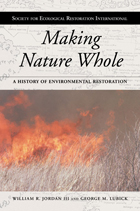
Making Nature Whole is a seminal volume that presents an in-depth history of the field of ecological restoration as it has developed in the United States over the last three decades. The authors draw from both published and unpublished sources, including archival materials and oral histories from early practitioners, to explore the development of the field and its importance to environmental management as well as to the larger environmental movement and our understanding of the world.
Considering antecedents as varied as monastic gardens, the Scientific Revolution, and the emerging nature-awareness of nineteenth-century Romantics and Transcendentalists, Jordan and Lubick offer unique insight into the field's philosophical and theoretical underpinnings. They examine specifically the more recent history, including the story of those who first attempted to recreate natural ecosystems early in the 20th century, as well as those who over the past few decades have realized the value of this approach not only as a critical element in conservation but also as a context for negotiating the ever-changing relationship between humans and the natural environment.
Making Nature Whole is a landmark contribution, providing context and history regarding a distinctive form of land management and giving readers a fascinating overview of the development of the field. It is essential reading for anyone interested in understanding where ecological restoration came from or where it might be going.
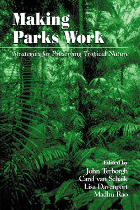
Most scientists and researchers working in tropical areas are convinced that parks and protected areas are the only real hope for saving land and biodiversity in those regions. Rather than giving up on parks that are foundering, ways must be found to strengthen them, and Making Parks Work offers a vital contribution to that effort. Focusing on the "good news" -- success stories from the front lines and what lessons can be taken from those stories -- the book gathers experiences and information from thirty leading conservationists into a guidebook of principles for effective management of protected areas. The book:
- offers a general overview of the status of protected areas worldwide
- presents case studies from Africa, Latin America, and Asia written by field researchers with long experience working in those areas
- analyzes a variety of problems that parks face and suggests policies and practices for coping with those problems
- explores the broad philosophical questions of conservation and how protected areas can -- and must -- resist the mounting pressures of an overcrowded world
Contributors include Mario Boza, Katrina Brandon, K. Ullas Karanth, Randall Kramer, Jeff Langholz, John F. Oates, Carlos A. Peres, Herman Rijksen, Nick Salafsky, Thomas T. Struhsaker, Patricia C. Wright, and others.

Despite a vast amount of effort and expertise devoted to them, many environmental conflicts have remained mired in controversy, stubbornly defying resolution. Why can some environmental problems be resolved in one locale but remain contentious in another, often carrying on for decades? What is it about certain issues or the people involved that make a conflict seemingly insoluble.
Making Sense of Intractable Environmental Conflicts addresses those and related questions, examining what researchers and experts in the field characterize as "intractable" disputes—intense disputes that persist over long periods of time and cannot be resolved through consensus-building efforts or by administrative, legal, or political means. The approach focuses on the "frames" parties use to define and enact the dispute—the lenses through which they interpret and understand the conflict and critical conflict dynamics. Through analysis of interviews, news media coverage, meeting transcripts, and archival data, the contributors to the book:
- examine the concepts of frames, framing, and reframing, and the role that framing plays in conflicts
- outline the essential characteristics of intractability and its major causes
- offer case studies of eight intractable environmental conflicts
- present a rich body of original interview material from affected parties
- set forth recommendations for intervention that can help resolve disputes
Conflicts examined include those over natural resource use, toxic pollutants, water quality, and growth. Specific conflicts examined are the Quincy Library Group in California; Voyageurs National Park in Minnesota; Edwards Aquifer in Texas; Doan Brook in Cleveland, Ohio; the Antidegradation Environmental Advisory Group in Ohio; Drake Chemical in Pennsylvania; Alton Park/Piney Woods in Tennessee; and three examples of growth-related conflicts along the Front Range of Colorado's Rocky Mountains.

In Making Transit Fun!, Nordahl shows that with the help of architects, urban designers, graphic artists, industrial engineers, marketing experts-and even fashion designers-we can lure people out of their automobiles and toward healthier, more sustainable methods of transportation.
This accessible E-ssential focuses on the possibilities for making public transit, cycling, and walking more appealing to the motorist. In each section, Nordahl demonstrates how the transit stigma can be overcome with innovative design. From the aesthetics of buses to segregated bike lanes and pedestrian-priority streets, Nordahl showcases examples from around the world that excite the heart and bring an easy smile.
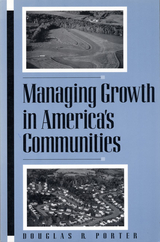
Communities across the country are turning to the concept of "growth management" to help plan for the future, as they seek to control the location, impact, character and timing of development in order to balance environmental and economic needs and concerns. Managing Growth in America's Communities presents practical information about proven strategies, programs and techniques of growth management for urban and rural communities. Topics examined include:
- public roles in community development
- determining locations and character of future development
- protecting environmental and natural resources
- managing infrastructure development
- preserving community character and quality
- achieving economic and social goals
- property rights concerns
Managing Growth in America's Communities is essential reading for community development specialists including government officials, planners, environmentalists, designers, developers, business people, and concerned citizens seeking innovative and feasible ways to manage growth.
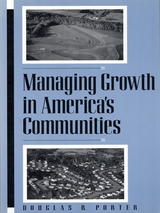
“Growth management” is essential today, as communities seek to control the location, impact, character and timing of development in order to balance environmental and economic needs and concerns. Managing Growth in America's Communities addresses all of the key considerations:
- Establishing public roles in community development;
- Determining locations and character of future development;
- Protecting environmental and natural resources;
- Managing infrastructure development;
- Preserving community character and quality;
- Achieving economic and social goals;
- Respecting property rights concerns.
The author, who is one of the nation’s leading authorities on managing community growth, provides examples from dozens of communities across the country, as well as state and regional approaches. Brief profiles present overviews of specific problems addressed, techniques utilized, results achieved, and contact information for further research. Informative sidebars offer additional perspectives from experts in growth management, including Robert Lang, Arthur C. Nelson, Erik Meyers, and others.
This new edition has been completely updated by the author. In particular, he considers issues of population growth, eminent domain, and the importance of design, especially “green” design. He also reports on the latest ideas in sustainable development, “smart growth,” neighborhood design, transit-oriented development, and green infrastructure planning. Like its predecessor, the second edition of Managing Growth in America's Communities is essential reading for anyone who is interested in how communities can grow intelligently.

In Managing the Climate Crisis, design and planning experts Jonathan Barnett and Matthijs Bouw take a practical approach to addressing the inevitable and growing threats from the climate crisis using constructed and nature-based design and engineering and ordinary government programs. They discuss adaptation and preventive measures and illustrate their implementation for seven climate-related threats: flooding along coastlines, river flooding, flash floods from extreme rain events, drought, wildfire, long periods of high heat, and food shortages.
The policies and investments needed to protect lives and property are affordable if they begin now, and are planned and budgeted over the next 30 years. Preventive actions can also be a tremendous opportunity, not only to create jobs, but also to remake cities and landscapes to be better for everyone. Flood defenses can be incorporated into new waterfront parks. The green designs needed to control flash floods can also help shield communities from excessive heat. Combating wildfires can produce healthier forests and generate creative designs for low-ignition landscapes and more fire-resistant buildings. Capturing rainwater can make cities respond to severe weather more naturally, while conserving farmland from erosion and encouraging roof-top greenhouses can safeguard food supplies.
Managing the Climate Crisis is a practical guide to managing the immediate threats from a changing climate while improving the way we live.
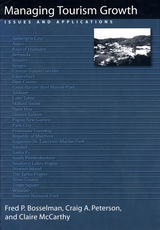
Tourism is by many measures the world's largest and fastest growing industry, and it provides myriad benefits to hosts and visitors alike. Yet if poorly managed, tourism can have serious negative impacts on tourist communities-their environment, physical appearance, economy, health, safety, and even their social values.
Managing Tourism Growth analyzes and evaluates methods by which communities can carefully control tourism in order to maximize the positive aspects while minimizing the detrimental effects. The authors offer vivid examples of the ways in which uncontrolled tourism can adversely affect a community, and explain how to create an effective strategy that can protect tourism resources for current and future generations.
Specific chapters provide detailed descriptions and evaluations of various approaches that communities around the world have successfully used. The authors examine alternative legal and regulatory measures, management techniques, and incentives that target tourism growth at all levels, from the quality of development, to its amount and rate of growth, to the locations in which it takes place. Approaches examined include: quality differentiation, performance standards, and trade-off strategies; preservation rules, growth limitations, and incremental growth strategies; expansion, dispersal, and concentration strategies, and identification of new tourism resources. The final chapter presents a concise and useful checklist of the elements of successful strategies that can help guide destination communities in the planning process.
An outstanding feature of the book is the numerous and varied case studies it offers, including Santa Fe, New Mexico; Milford Sound, New Zealand; Nusa Dua, Bali; Great Barrier Reef, Australia; Sanibel, Florida; Canterbury, England; Republic of Maldives; Bruges, Belgium; Times Square, New York; Papua New Guinea; Park City, Utah; Whistler, British Columbia; and many others.
The depth and accessibility of information provided, along with the wealth of global case studies, make the book must-reading for planning professionals, government officials, tourism industry executives, consultants, and faculty and students of geography, planning, or tourism.


Humans are terrestrial animals, and our capacity to see and understand the importance and vulnerability of life in the sea has trailed our growing ability to harm it. While conservation biologists are working to address environmental problems humans have created on land, loss of marine biodiversity, including extinctions and habitat degradation, has received much less attention. At the same time, marine sciences such as oceanography and fisheries biology have largely ignored issues of conservation.
Marine Conservation Biology brings together for the first time in a single volume, leading experts from around the world to apply the lessons and thinking of conservation biology to marine issues. Contributors including James M. Acheson, Louis W. Botsford, James T. Carlton, Kristina Gjerde, Selina S. Heppell, Ransom A. Myers, Julia K. Parrish, Stephen R. Palumbi, and Daniel Pauly offer penetrating insights on the nature of marine biodiversity, what threatens it, and what humans can and must do to recover the biological integrity of the world's estuaries, coastal seas, and oceans.
Sections examine: distinctive aspects of marine populations and ecosystems; threats to marine biological diversity, singly and in combination; place-based management of marine ecosystems; the often-neglected human dimensions of marine conservation.
Marine Conservation Biology breaks new ground by creating the conceptual framework for the new field of marine conservation biology -- the science of protecting, recovering, and sustainably using the living sea. It synthesizes the latest knowledge and ideas from leading thinkers in disciplines ranging from larval biology to sociology, making it a must-read for research and teaching faculty, postdoctoral fellows, and graduate and advanced undergraduate students (who share an interest in bringing conservation biology to marine issues). Likewise, its lucid scientific examinations illuminate key issues facing environmental managers, policymakers, advocates, and funders concerned with the health of our oceans.
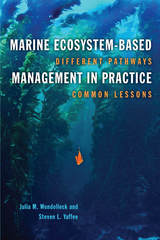
Marine Ecosystem-Based Management in Practice is the first practical guide for the marine conservation realm. In a unique collection of case studies, the authors showcase successful collaborative approaches to ecosystem-based management. The authors introduce the basic concepts of ecosystem-based management and five different pathways for making progress from community to multinational levels. They spotlight the characteristics that are evident in all successful cases —the governance structures and social motivations that make it work. Case analyses ranging from the Gulf of Maine to the Channel Islands in Southern California comprise the bulk of the book, augmented by text boxes showcasing examples of guiding documents important to the process. They devote several ending chapters to discussion of the interpersonal relationships critical to successful implementation of marine ecosystem-based management. The book concludes with a discussion of the implications for policy and on-the-ground practice.
This book offers a hopeful message to policy makers, managers, practitioners, and students who will find this an indispensable guide to field-tested, replicable marine conservation management practices that work.

Conventional fishery management practices have failed to prevent the collapse of numerous fish stocks around the world. Amid growing concern about our ability to protect marine biodiversity and ecosystem integrity, scientists and managers alike are seeking alternative management tools. One of the most promising of those is no-take marine reserves -- areas of the sea where all consumptive use of natural resources is prohibited.
Marine Reserves is the first guidebook on no-take marine reserves, providing a synthesis of information on the underlying science, as well as design and implementation issues. The book, by Jack Sobel and Craig Dahlgren, describes the need for marine reserves and their potential benefits, examines how reserves can be designed to achieve specific objectives, and considers gaps in our knowledge and the research needed to address those gaps. Chapters examine: marine biological and geophysical issues relevant to reserve design; potential economic and biological benefits of marine reserves, and the likelihood of achieving them; influence of social and economic factors on reserve design and implementation; lessons learned from past efforts to establish marine reserves.
Also included are three case studies from California, Belize, and the Bahamas, as well as a review of experiences globally across a broad range of geographical locations, socioeconomic conditions, and marine environments. Case studies provide background on the history of marine reserves in each location, the process by which reserves were created, and the effect of the reserves on marine populations and communities as well as on human communities.
Marine Reserves represents an invaluable guide for fishery managers and marine protected area managers in creating and implementing effective marine reserves, and an accessible reference for environmentalists and others concerned with the conservation of marine resources. It will also be useful in undergraduate and graduate courses in marine ecology, fisheries, marine policy, and related fields.

As an astrophysicist at NASA, Kuchner knows that "marketing" can seem like a superficial distraction, whether your daily work is searching for new planets or seeking a cure for cancer. In fact, he argues, it's a critical component of the modern scientific endeavor, not only advancing personal careers but also society's knowledge.
Kuchner approaches marketing as a science in itself. He translates theories about human interaction and sense of self into methods for building relationships-one of the most critical skills in any profession. And he explains how to brand yourself effectively-how to get articles published, give compelling presentations, use social media like Facebook and Twitter, and impress potential employers and funders.
Like any good scientist, Kuchner bases his conclusions on years of study and experimentation. In Marketing for Scientists, he distills the strategies needed to keep pace in a Web 2.0 world.
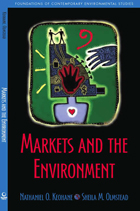
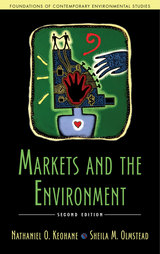
The authors provide a concise yet thorough introduction to the economic theory of environmental policy and natural resource management. They begin with an overview of environmental economics before exploring topics including cost-benefit analysis, market failures and successes, and economic growth and sustainability. Readers of the first edition will notice new analysis of cost estimation as well as specific market instruments, including municipal water pricing and waste disposal. Particular attention is paid to behavioral economics and cap-and-trade programs for carbon.
Throughout, Markets and the Environment is written in an accessible, student-friendly style. It includes study questions for each chapter, as well as clear figures and relatable text boxes. The authors have long understood the need for a book to bridge the gap between short articles on environmental economics and tomes filled with complex algebra. Markets and the Environment makes clear how economics influences policy, the world around us, and our own lives.
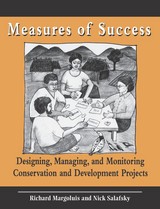
Measures of Success is a practical, hands-on guide to designing, managing, and measuring the impacts of community-oriented conservation and development projects. It presents a simple, clear, logical, and yet comprehensive approach to developing and implementing effective programs, and can help conservation and development practitioners use principles of adaptive management to test assumptions about their projects and learn from the results.
The book presents a systematic approach to improving the focus, effectiveness, and efficiency of projects, with specific guidelines and advice on:
- designing a realistic conceptual framework based on local site conditions
- developing clearly defined goals, objectives, and activities
- creating a monitoring plan that can be used to assess whether goals and objectives are being met
- integrating social and biological science techniques to collect the most relevant and useful data in the most cost-effective way
- using the information obtained through the monitoring plan to modify the project and learn from the result
The text is developed in eight chapters that follow the structure of a planning process from conception to completion, with the chapters linked by four scenarios that serve as teaching case studies throughout the book. Examples from these scenarios illustrate the processes and tools discussed, and each scenario case study is presented in its entirety in an appendix to the volume. The approach has been developed and field tested by practitioners working in many different projects in Latin America, Africa, and Asia, and their experience and input ensure that the guide is both practical and useful.
Measures of Success is the only work of its kind currently available, and represents an invaluable resource for field-based practitioners, project managers, and local community leaders, as well as for international NGO staff, college and university teachers and students, researchers, and government officials.
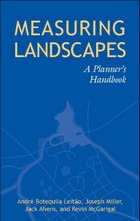
The authors explain specific tools and concepts to measure a landscape's structure, form, and change over time. Metrics studied include patch richness, class area proportion, patch number and density, mean patch size, shape, radius of gyration, contagion, edge contrast, nearest neighbor distance, and proximity. These measures will help planners and conservationists make better land use decisions for the future.
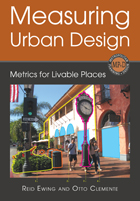
In recent years, many "walking audit instruments" have been developed to measure qualities like building height, block length, and sidewalk width. But while easily quantifiable, these physical features do not fully capture the experience of walking down a street. In contrast, this book addresses broad perceptions of street environments. It provides operational definitions and measurement protocols of five intangible qualities of urban design, specifically imageability, visual enclosure, human scale, transparency, and complexity.
The result is a reliable field survey instrument grounded in constructs from architecture, urban design, and planning. Readers will also find a case study applying the instrument to 588 streets in New York City, which shows that it can be used effectively to measure the built environment's impact on social, psychological, and physical well-being. Finally, readers will find illustrated, step-by-step instructions to use the instrument and a scoring sheet for easy calculation of urban design quality scores.
For the first time, researchers, designers, planners, and lay people have an empirically tested tool to measure those elusive qualities that make us want to take a stroll. Urban policymakers and planners as well as students in urban policy, design, and environmental health will find the tools and methods in Measuring Urban Design especially useful.
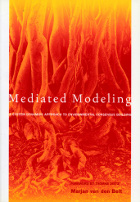
Mediated modeling is an innovative new approach that enhances the use of computer models as invaluable tools to guide policy and management decisions. Rather than having outside experts dispensing answers to local stakeholders, mediated modeling brings together diverse interests to raise the shared level of understanding and foster a broad and
deep consensus. It provides a structured process based on system dynamics thinking in which community members, government officials, industry representatives, and other stakeholders can work together to produce a coherent, simple but elegant simulation model.
Mediated Modeling by Marjan Van Den Belt is a practical guide to participatory modeling for both practitioners and students, one that is firmly theoretically grounded in the field of systems dynamics and environmental modeling. Five in-depth case studies describe the successful use of the technique in a variety of settings, and a final chapter synthesizes the lessons highlighted by the case studies.
Mediated Modeling's step-by-step description of the techniques and practical advice regarding implementation offer a real-world solution for all those seeking to make sound decisions about the environment.

Shamichael Hallman argues that the public library may be our best hope for bridging these divides and creating strong, inclusive communities. While public libraries have long been thought of as a place for a select few, increasingly they are playing an essential role in building social cohesion, promoting civic renewal, and advancing the ideals of a healthy democracy. Many are reimagining themselves in new and innovative ways, actively reaching out to the communities they serve. Today, libraries are becoming essential institutions for repairing society.
Libraries have a unique opportunity to bridge socioeconomic divides and rebuild trust. But in order to do so, they must be truly welcoming to all. They and their communities must work collaboratively to bridge socioeconomic divides through innovative and productive partnerships.
Drawing from his experience at the Memphis Public Library and his extensive research and interviews across the country, Hallman presents a rich argument for seeing libraries as one of the nation’s greatest assets. He includes examples from libraries large and small--such as the Iowa’s North Liberty Library’s Lighthouse in the Library program to bring people together to discuss important topics in a safe and supportive space, to Cambridge Cooks, an initiative of the Cambridge MA Public Library that fosters social connection by bringing people together over shared interest in food.
As an institution that is increasingly under attack for creating a place where diverse audiences can see themselves, public libraries are under more scrutiny than ever. Meet Me at the Library offers us a revealing look at one of our most important civic institutions and the social and civic impact they must play if we are to heal our divided nation.

The concept of “the city” —as well as “the state” and “the nation state” —is passé, agree contributors to this insightful book. The new scale for considering economic strength and growth opportunities is “the megaregion,” a network of metropolitan centers and their surrounding areas that are spatially and functionally linked through environmental, economic, and infrastructure interactions.
Recently a great deal of attention has been focused on the emergence of the European Union and on European spatial planning, which has boosted the region’s competitiveness. Megaregions applies these emerging concepts in an American context. It addresses critical questions for our future: What are the spatial implications of local, regional, national, and global trends within the context of sustainability, economic competitiveness, and social equity? How can we address housing, transportation, and infrastructure needs in growing megaregions? How can we develop and implement the policy changes necessary to make viable, livable megaregions?
By the year 2050, megaregions will contain two-thirds of the U.S. population. Given the projected growth of the U.S. population and the accompanying geographic changes, this forward-looking book argues that U.S. planners and policymakers must examine and implement the megaregion as a new and appropriate framework.
Contributors, all of whom are leaders in their academic and professional specialties, address the most critical issues confronting the U.S. over the next fifty years. At the same time, they examine ways in which the idea of megaregions might help address our concerns about equity, the economy, and the environment. Together, these essays define the theoretical, analytical, and operational underpinnings of a new structure that could respond to the anticipated upheavals in U.S. population and living patterns.

Development of rural landscapes is converting once-vast expanses of open space into pockets of habitat where wildlife populations exist in isolation from other members of their species. The central concept of metapopulation dynamics -- that a constellation of partially isolated patches can yield overall stability to a system that is chaotic at the level of the individual patch -- offers an important new way of thinking about the conservation and management of populations dispersed among small habitat fragments. This approach is proving to be a rich resource for biologists hoping to arrest the current catastrophic loss of biodiversity.
An understanding of metapopulation theory and analysis is critical to the modern practice of wildlife conservation and management. This volume provides a comprehensive overview of the subject, addressing the needs of an applied professional audience for comprehensible information to integrate into their practices. Leading conservation biologists, ecologists, wildlife managers, and other experts consider the emergence and development of metapopulation theory and explore its applicability and usefulness to real-world conservation programs.
Introductory chapters provide background information on basic concepts such as models, genetics, landscape configuraton, and edges and corridors. Subsequent chapters present detailed methods of analyzing metapopulation structure. Case studies of an array of vertebrate species, including the Swedish pool frog, the northern spotted owl, Stephens' kangaroo rat, Florida scrub jay, Mediterranean monk seal, Steller sea lion, tule elk, and others, illustrate nuances of metapopulation theory analysis and its practical applications.
Contributors describe what metapopulation approaches bring to wildlife conservation and management, present models of how metapopulation thinking has been applied in specific situations, and suggest the analysis required in given cases. Metapopulations and Wildlife Conservation is essential reading for anyone working in the field of wildlife conservation and managment.
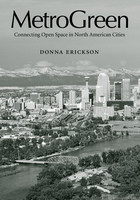
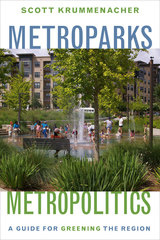
Author Scott Krummenacher has studied greenspace systems for years, and offers answers to questions about engaging stakeholders and getting the resources and support that planners need. Krummenacher takes a detailed look at two comparable yet challenging metro areas, St. Louis and Kansas City, which have each created successful regional greenspace plans in different ways. He shows how the lessons they offer from their differing approaches can be incorporated into a strategy for any region, any greenspace initiative. Metroparks, Metropolitics combines rigorous policy analysis with key insights from policymakers, activists, and others who have been involved in successful campaigns.
While this book can’t guarantee that establishing a regional greenspace network will be easy, it is filled with both wisdom and practical advice for handling the obstacles that inevitably come up during these ambitious undertakings.

The magnificent stands of old-growth trees that characterize the forests of western North America depend on periodic fires for their creation or survival. Deprived of that essential disturbance process eventually they die, leaving an overcrowded growth of smaller trees vulnerable to intense blazes and epidemics of insects and disease.
In Mimicking Nature's Fire, forest ecologists Stephen Arno and Carl Fiedler present practical solutions to the pervasive problem of deteriorating forest conditions in western North America. Advocating a new direction in forest management, they explore the promise of "restoration forestry" -- an ecologically based approach that seeks to establish forest structures in which fire can once again serve as a beneficial process rather than as a destructive aberration.
The book begins with an overview of fundamentals: why traditional forestry tried to exclude fire from forests, why that attempt failed, and why foresters and ecologists now recognize the need for management based on how natural ecosystems operate. Subsequent chapters consider: how fire's historic role provides a foundation for designing restoration strategies; why a hands-off approach will not return forests to their historical condition; how management goals influence the strategies used in restoration forestry.
The second part of the book presents case studies of restoration projects in the western United States and Canada, representing different forest types, different historic fire regimes, and contrasting management goals. For each project, the authors describe why and how the project is being conducted, profile forest conditions, and describe methods of treatment. They also report what has been accomplished, identify obstacles to restoration, and offer their candid but understanding evaluation. Mimicking Nature's Fire concludes by placing restoration forestry in the broad context of conserving forests worldwide and outlining factors critical for its success.

We all remember the famous tagline: better living through chemistry. But in recent years, that promise has been distorted, as serious health effects have been traced to the chemicals in everyday products. When a plastic baby bottle can interfere with brain and reproductive development, you know something is missing.
John Warner is working to fill in the pieces. Starting out as a musician, Warner never thought he would enter the sciences, let alone become a world-renowned chemist. Yet through extraordinary professional and personal experiences, he not only learned to create safe, environmentally-friendly chemicals, but discovered what was broken in the system. From an educational approach that teaches chemistry through rote instruction rather than creative exploration, to business models that short-shrift R&D, society at large is not fostering the development of benign chemicals.
The Missing Elements proposes a path forward, arguing for straightforward changes in education, business, government, philanthropy, and personal behavior that would support the universal adoption of green chemistry. The scale of reform is substantial, but so is the possibility when we restore chemistry’s promise.
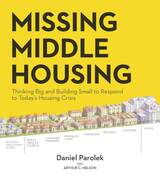
Missing Middle Housing, a term coined by Daniel Parolek, describes the walkable, desirable, yet attainable housing that many people across the country are struggling to find. Missing Middle Housing types—such as duplexes, fourplexes, and bungalow courts—can provide options along a spectrum of affordability.
In Missing Middle Housing, Parolek, an architect and urban designer, illustrates the power of these housing types to meet today’s diverse housing needs. With the benefit of beautiful full-color graphics, Parolek goes into depth about the benefits and qualities of Missing Middle Housing. The book demonstrates why more developers should be building Missing Middle Housing and defines the barriers cities need to remove to enable it to be built. Case studies of built projects show what is possible, from the Prairie Queen Neighborhood in Omaha, Nebraska to the Sonoma Wildfire Cottages, in California. A chapter from urban scholar Arthur C. Nelson uses data analysis to highlight the urgency to deliver Missing Middle Housing.
Parolek proves that density is too blunt of an instrument to effectively regulate for twenty-first-century housing needs. Complete industries and systems will have to be rethought to help deliver the broad range of Missing Middle Housing needed to meet the demand, as this book shows. Whether you are a planner, architect, builder, or city leader, Missing Middle Housing will help you think differently about how to address housing needs for today’s communities.
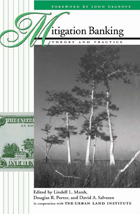
Under the Clean Water Act, development that results in the permanent destruction of wetlands must, in most cases, be mitigated by the creation of a new wetland or the restoration of a degraded one. In recent years, the concept of "mitigation banking" has emerged. Rather than require developers to create and maintain wetlands on their own on a quid pro quo basis, mitigation banking allows them to pay for wetlands that have been created and maintained properly by others to compensate for their damage.
The contributors to this volume provide an overview of mitigation banking experience in the United States, examine the key issues and concerns -- from providing assurances to determining the value of credits -- and describe the practice of developing and operating a mitigation bank. Topics include:
- history and current experience of mitigation banking
- policies and concerns of local, state, and federal agencies
- economics of mitigation banking
- funding, management, and operation of banks
- starting a mitigation bank
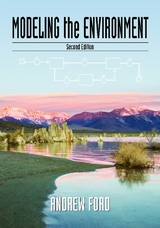
System dynamics is one of the most widely known and widely used methods of modeling. The fundamental principles of this approach are demonstrated here with a wide range of examples, including geo-hydrology, population biology, epidemiology and economics. The applications demonstrate the transferability of the systems approach across disciplines, across spatial scales, and across time scales. All of the models are implemented with stock and flow software programs such as Stella and Vensim. These programs are easy and fun to learn, and they allow students to develop realistic models within the first few weeks of a college course.
System dynamics has emerged as the most common approach in collaborative projects to address environmental problems. The stock and flow structures and the emphasis on feedback control provide a common language that is understood by scientists from many disciplines. Although the interdisciplinary approach described here is widely used in practice, there are few books to aid instruction. Modeling the Environment meets the urgent need for instructional materials in interdisciplinary modeling of environmental systems.
Visit http://www.wsu.edu/~forda/AA2nd.html for valuable classroom materials.
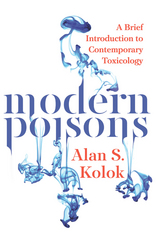
This accessible book explains basic principles in plain language while illuminating the most important issues in contemporary toxicology. Kolok begins by exploring age-old precepts of the field such as the dose-response relationship and the concept, first introduced by Ambroise Paré in the sixteenth century, that a chemical’s particular action depends on its inherent chemical nature. The author goes on to show exactly how chemicals enter the body and elicit their toxic effect, as well as the body’s methods of defense.
With the fundamentals established, Kolok digs into advances in toxicology, tracing the field’s development from World War II to the present day. The book examines both technical discoveries and their impacts on public policy. Highlights include studies of endocrine-disrupting chemicals in toiletries and prescriptions, the emerging science on prions, and our growing understanding of epigenetics.
Readers learn not only how toxic exposure affects people and wildlife, but about the long-term social and environmental consequences of our chemicals. Whether studying toxicology itself, public health, or environmental science, readers will develop a core understanding of—and curiosity about—this fast-changing field.

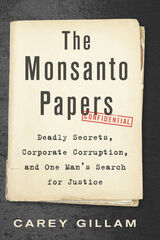
The Monsanto Papers is the inside story of Lee Johnson’s landmark lawsuit against Monsanto. For Lee, the case was a race against the clock, with doctors predicting he wouldn’t survive long enough to take the witness stand. For the eclectic band of young, ambitious lawyers representing him, it was a matter of professional pride and personal risk, with millions of dollars and hard-earned reputations on the line. For the public at large, the lawsuit presented a question of corporate accountability. With enough money and influence, could a company endanger its customers, hide evidence, manipulate regulators, and get away with it all—for decades?
Readers will be astounded by the depth of corruption uncovered, captivated by the shocking twists, and moved by Lee’s quiet determination to see justice served. With gripping narrative force that reads like fiction, The Monsanto Papers takes readers behind the scenes of a grueling legal battle, pulling back the curtain on the frailties of the American court system and the lengths to which lawyers will go to fight corporate wrongdoing.
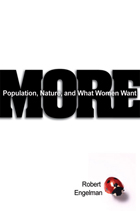
The phenomenon has some lamenting the imminent extinction of humanity, while others warn that our numbers will soon outgrow the planet’s resources. Robert Engelman offers a decidedly different vision—one that celebrates women’s widespread desire for smaller families. Mothers aren’t seeking more children, he argues, but more for their children. If they’re able to realize their intentions, we just might suffer less climate change, hunger, and disease, not to mention sky-high housing costs and infuriating traffic jams.
In More, Engelman shows that this three-way dance between population, women’s autonomy, and the natural world is as old as humanity itself. He traces pivotal developments in our history that set population—and society—on its current trajectory, from hominids’ first steps on two feet to the persecution of “witches” in Europe to the creation of modern contraception. Both personal and sweeping, More explores how population growth has shaped modern civilization—and humanity as we know it.
The result is a mind-stretching exploration of parenthood, sex, and culture through the ages. Yet for all its fascinating historical detail, More is primarily about the choices we face today. Whether society supports women to have children when and only when they choose to will not only shape their lives, but the world all our children will inherit.
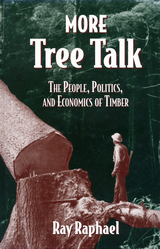
More Tree Talk is an insightful and compelling look at the human dimension of the challenges facing forestry. First published in 1981, Tree Talk was widely hailed as the most even-handed and well-written introduction to forestry issues available. More Tree Talk is an entirely revised edition of that classic volume that brings the book up-to-date with the current situation.
Like the original, More Tree Talk features a running narrative punctuated by individual portraits that personalize the issues. It translates political and academic aspects of forestry into human terms, focusing on those whose lives and livelihoods depend on the outcome of the debates currently raging -- old-time woodsmen, loggers, naturalists, restoration workers, timber company executives.
Ray Raphael explores the new forestry practices, theories, and controversies that have emerged in the past decade as he addresses problems of a declining resource base and increasing regulatory policies. He examines the impact of ecological and economic concerns on rural communities, and considers the possibility of large structural changes in the ways in which timber companies operate. Throughout, he emphasizes that without an understanding of the economic and political factors that interfere with good forest management, all the scientific knowledge -- and all the best intentions of on-site workers -- will come to no avail.
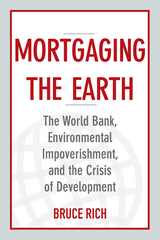
Bruce Rich argues that the Bank’s current institutional problems are extensions of flaws that had been present since its founding. His new book, Foreclosing the Future, tells the story of the Bank from the Rio Earth Summit to today. For readers who want the full history of the Bank’s environmental record, Rich’s acclaimed 1994 critique, Mortgaging the Earth, is an essential companion.
Called a “detailed and thought-provoking look at an important subject” by The New York Times, Mortgaging the Earth analyzes the twenty year period leading up the Rio Summit. Rich offers not only an important history but critical insights about economic development that are ever-more relevant today.
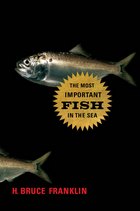

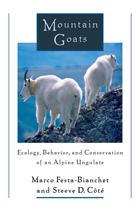
This book offers the first comprehensive assessment of the ecology and behavior of mountain goats, setting forth the results of a remarkable 16-year longitudinal study of more than 300 marked individuals in a population in Alberta, Canada. The authors’ thorough, long-term study allowed them to draw important conclusions about mountain goat ecology—including individual reproductive strategies, population dynamics, and sensitivity to human disturbance—and to use those conclusions in offering guidance for developing effective conservation strategies.
Chapters examine:
-habitat use, vegetation quality, and seasonal movements
-sexual segregation and social organization
-individual variability in yearly and lifetime reproductive success of females
-age- and sex-specific survival and dispersal
-reproductive strategies and population dynamics
-management and conservation of mountain goats
The book also draws on the rich literature on long-term monitoring of marked ungulates to explore similarities and differences between mountain goats and other species, particularly bighorn sheep and ibex.
By monitoring a marked population over a long period of time, researchers were able to document changes in sex-age structure and identify factors driving population dynamics. Because it explores the links between individual life-history strategy and population dynamics in a natural setting, Mountain Goats will be an invaluable resource for wildlife managers, researchers in ecology and animal behavior, conservationists, population biologists, and anyone concerned with the ecology and management of natural populations, especially in alpine environments.

—Bill McKibben, author of The Flag, The Cross, and the Station Wagon
Almost everywhere in the world, streets are designed for travel at the highest speed, giving precedence to the chunkiest vehicles. We take for granted that the streets outside of our homes are designed only for movement from one point to another. But what happens if we radically rethink how we use these public spaces? Could we change our lives for the better?
In Movement: How to Take Back Our Streets and Transform Our Lives, journalist Thalia Verkade and mobility expert (“the cycling professor”) Marco te Brömmelstroet take a three-year shared journey of discovery into the possibilities of our streets. They investigate and question the choices and mechanisms underpinning how these public spaces are designed and look at how they could be different. Verkade and te Brömmelstroet draw inspiration from the Netherlands and look at what other countries are doing, and could do, to diversify how they use their streets and make them safer.
During the pandemic, decision-makers in cities around the world were confronted with the questions of who our streets belong to, how we want to use them, and who gets to decide. Making our communities safer, cleaner, and greener starts with asking these fundamental questions. To truly transform mobility, we need to look far beyond the technical aspects and put people at the center of urban design. Movement will change the way that you view our streets.

That experience, along with the guidance of leaders in systems thinking and racial justice, convinced her that the world’s thorniest problems may be easier to tackle together than one by one. That’s multisolving: using a single investment of time or money to solve many problems at the same time. (Reduced fossil fuel use = improvements in climate, health, equity, economics, and more.) While the idea of killing two birds with one stone (or “filling two needs with one deed”) is age-old, and the notion of co-benefits in policy-making has been around for years, Multisolving addresses the current mismatch between complex, deeply intertwined societal issues and our siloed approach to them.
This unique resource is for local school boards that need revenue for their students but don’t want to overtax low-income seniors. It is for nonprofits working to reduce food waste and combat the root causes of hunger while increasing racial justice. It is for seaside communities that can protect themselves from flooding while also improving biodiversity with a living coastline. It may also be for you: doing the work you know is imperative but that is sometimes overwhelming, a tiny a drop in a swirling ocean.
Multisolving can’t promise a list of “fifty simple things to make everything OK.” What it does offer are strategies to build solidarity between diverse groups, overcome powerful interests, and create last change that benefits us all.
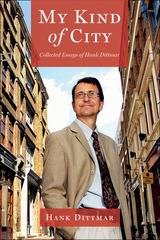
—Scott Bernstein, Founder and Chief Strategy + Innovation Officer, Center for Neighborhood Technology
Hank Dittmar was a globally recognized urban planner, advocate, and policy advisor. He wrote extensively on a wide range of topics, including architectural criticism, community planning, and transportation policy over his long and storied career.
In My Kind of City, Dittmar has organized his selected writings into ten sections with original introductions. His observations range on scale from local ("My Favorite Street: Seven Dials, Covent Garden, London") to national ("Post Truth Architecture in the Age of Trump") and global ("Architects are Critical to Adapting our Cities to Climate Change"). Andrés Duany writes of Hank in the book foreword, "He has continued to search for ways to engage place, community and history in order to avoid the tempting formalism of plans."
The range of topics covered in My Kind of City reflects the breadth of Dittmar's experience in working for better cities for people. Common themes emerge in the engaging prose including Dittmar's belief that improving our cities should not be left to the "experts"; his appreciation for the beautiful and the messy; and his rare combination of deep expertise and modesty. As Lynn Richards, CEO of Congress for the New Urbanism expresses in the preface, "Hank's writing is smart without being elitist, witty and poetic, succinct and often surprising."
My Kind of City captures a visionary planner's spirit, eye for beauty, and love for the places where we live.

In My Kind of Transit, Darrin Nordahl argues that like life itself, transportation isn't only about the destination, but the journey. Public transit reduces traffic and pollution, yet few of us are willing to get out of our cars and onto subways and buses. But Nordahl demonstrates that when using public transit is an enjoyable experience, tourists and commuters alike willingly hand in their keys.
The trick is creating a system that isn't simply a poor imitation of the automobile, but offers its own pleasures and comforts. While a railway or bus will never achieve the quiet solitude of a personal car, it can provide, much like a well-designed public park, an inviting, communal space.
My Kind of Transit is an animated tour of successful transportation systems, offering smart, commonsense analysis of what makes transit fun. Nordahl draws on examples like the iconic street cars of New Orleans and the picturesque cable cars in San Francisco, illustrating that the best transit systems are uniquely tailored to their individual cities. He also describes universal principles of good transit design.
Nordahl's humanistic treatment will help planners, designers, transportation professionals, and policymakers create transit systems the public actually wants to ride. And it will introduce all readers to delightful ways of getting from point A to point B.
READERS
Browse our collection.
PUBLISHERS
See BiblioVault's publisher services.
STUDENT SERVICES
Files for college accessibility offices.
UChicago Accessibility Resources
home | accessibility | search | about | contact us
BiblioVault ® 2001 - 2024
The University of Chicago Press









